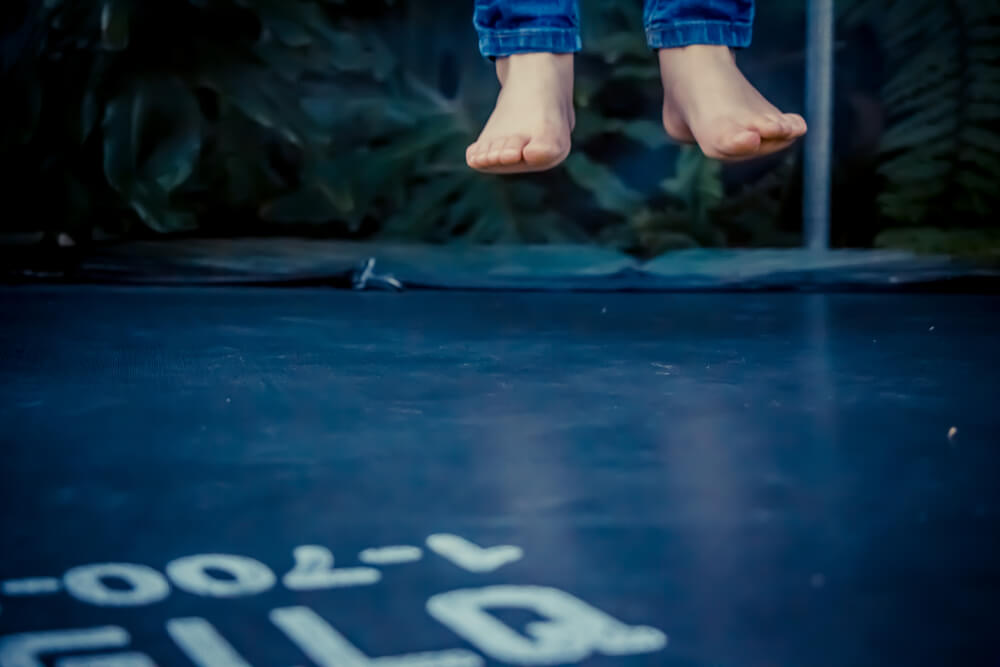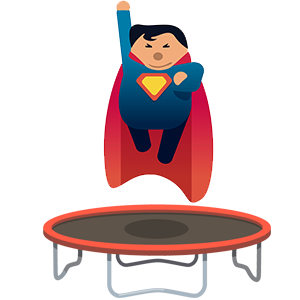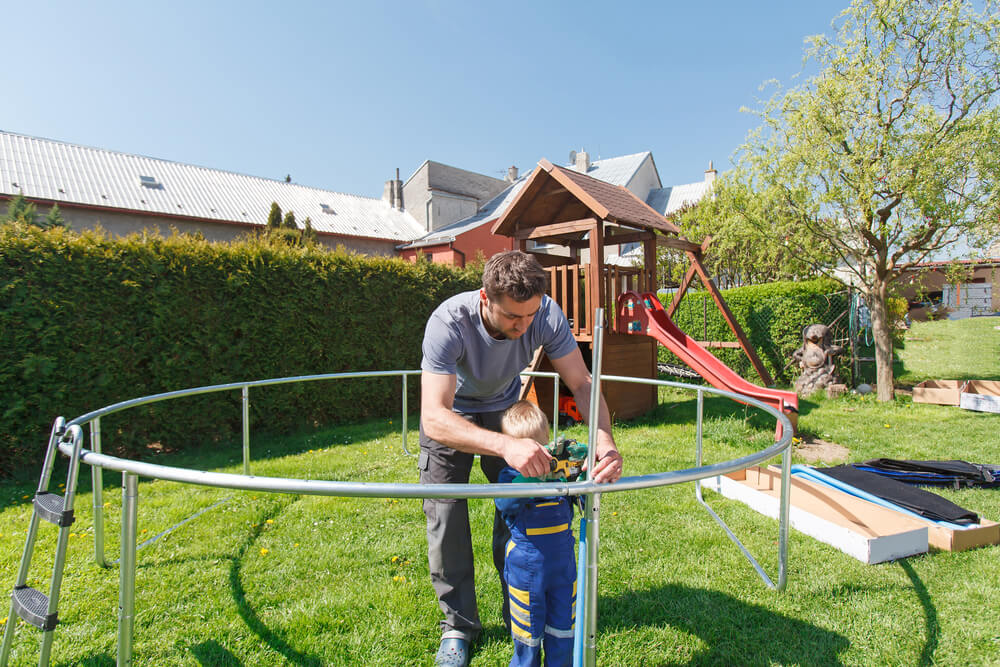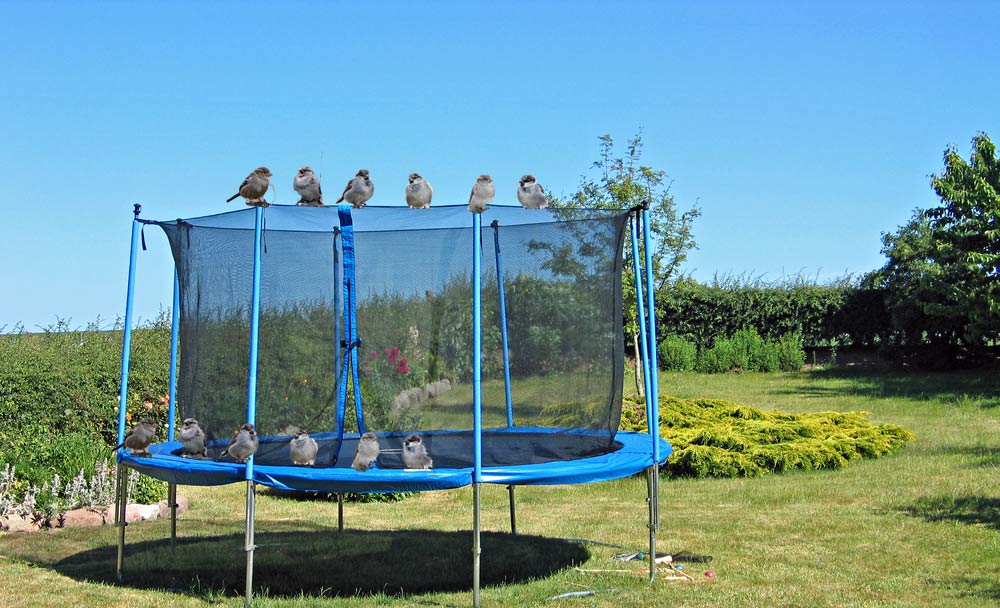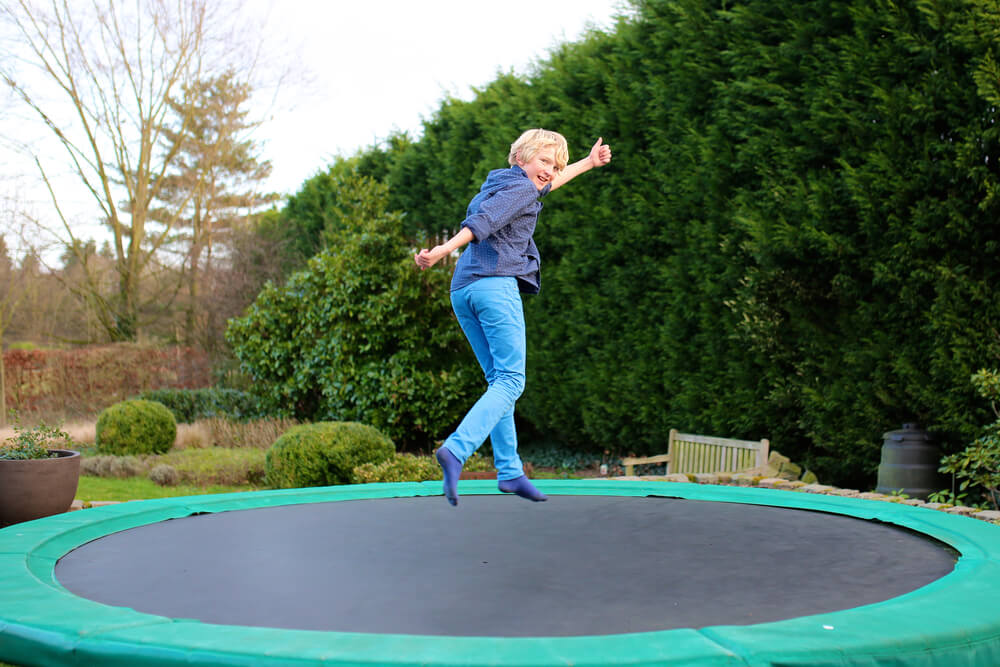How do you keep an outdoor trampoline clean? Here’s a complete guide
Cleaning a trampoline can be the most straightforward maintenance task you’ll do to keep it in excellent working condition. The trampoline mat is especially sensitive to dirt and debris, which can eat into its fabric over time. Remove all dirt and debris regularly, and the mat and safety pads can last a long time.
But there’s a right and wrong way to clean trampolines.
Do it wrong, and you’ll need to buy replacements and do repairs sooner than later.
This guide will break down how to properly clean a trampoline to keep working for decades and safe for users.
But first, a little background.
Is a dirty trampoline dangerous?
Removing debris off a trampoline mat is crucial for trampoline safety. Bird poop, sticks, leaves, pebbles, and candy can all make your trampoline slippery. Awkward slips can lead to joint twists and broken limbs. And sliding out of control near the edge can lead to falling off the trampoline. That can lead to further injuries, which can include hitting your head on the ground. You do not want that.
How regularly should you clean a trampoline?
Clean your trampoline whenever you notice loose dirt before it can harden. You do not need to clean a trampoline frequently. Neither do you need to have a strict cleaning schedule. After all, the bouncer can gather lichen and debris between cleans.
Will water ruin a trampoline?
Water exposure won’t damage your trampoline unless it is not made out of galvanized steel. In that case, apply a water repellant in advance to protect the frame and springs from rusting. Then wet a soft cloth and use it to rub down the dirty parts on the mat.
That’s not all.
Leaving the trampoline wet for long stretches can encourage mold growth. And that can eat into the mat’s fabric, damaging it over time.
Here’s something else if you’ve ever been tempted to turn your trampoline into a mini slip ‘n slide.
Drain the cleaning water so it won’t gather up in the middle of the trampoline mat to a point where it weighs more than the trampoline’s weight limit. Otherwise, it can weaken the trampoline’s structural integrity.
Do you need to remove the safety netting to clean a trampoline?
Removing a trampoline’s enclosure can help you clean it without interruptions. But you do not have to. You can hike up the netting if removing it feels like too much work. Preferably, use your manufacturer’s recommended netting broom to dust it down. But if you prefer to remove it, be sure to reinstall it before anyone can jump on the trampoline.
There’s more.
Keep the enclosure net’s zipper clean, too. You’ll often see people recommend using WD40 or grease to keep the zippers working well.
Yet those tend to attract and trap even more dirt, further clogging the zipping mechanism. Instead, apply small amounts of petroleum jelly with your fingers.
Now, how do you deep clean a trampoline?
It is simple and fun.
What is the Best Way to Clean a Trampoline?
You are going to be doing three things; sweeping, hosing, and scrubbing. Often, you’ll only need to clean the bouncer’s mat and dust its netting. Scrubbing and hosing come into play only if you have sticky or hardened dirt to remove.
Let’s talk about those scenarios, shall we?
How do you clean leaves off a trampoline?
Sweep them off. Use a household broom with soft bristles or twigs. It can be long- or short-handled. You can then use a trampoline net with a miniature mesh pattern to keep twigs, pebbles, and leaves from blowing into the netted enclosure.
Remember to keep the trampoline about eight feet from a tree.
Although the shade can be great for your mat, falling tree parts, especially in autumn, can demand frequent sweeps–up to several times a day.
Moreover, you risk collecting sharp twigs and slippery leaves on the surface, a safety issue if anyone steps or bounces on them.
How do I get bird poop off my trampoline?
Soak the trampoline in warm water before giving it a nice scrubbing-down. You can use laundry soap or a mild detergent to clean the trampoline surface thoroughly. Remember to rinse the surface thoroughly after that.
But wait, does soap ruin a trampoline?
As long as the soap or detergent is non-abrasive, freely use them to clean your bouncer. Use up to five parts water for every one-part soap or mild detergent. Again, always ensure you thoroughly rinse the surface to remove any slip and slide tendencies.
Also, watch your steps when using soap on a trampoline mat.
Soaping can quickly turn it into a slippery danger zone, especially if you opt to clean it on bare feet. So, consider wearing light sandals with good traction to improve your balance on the slippery surface. Ensure the pair is flat-bottomed to avoid pricking through the mat’s fabric work.
How do you clean off mold on your trampoline?
Removing mold from a trampoline can be tricky. But it is straightforward. You’ll need to use warm water, a mild household detergent, a soft brush, and gloves if you are allergic to mold. Then let the trampoline air out and receive sunshine to dry naturally.
Ideally, use a special anti-fungal spray to protect it from further fungus growth. Otherwise, mold growth can cause allergy and infection to jumpers.
Note: Remember to scrub gently, too. You do not want to scrape off parts of your trampoline while at it because that can further expose the structure to the elements and rust agents.
Growing mold on a trampoline is an indication that you have a toxic combination of dampness and a lack of sunshine in the affected spots.
This is a common problem for in-ground trampolines that have insufficient drainage and ventilation systems. You can read our guide for how to install an in-ground trampoline the right way here to prevent that from happening in your case.
Oh, another thing.
Avoid covering your outdoor trampoline. That will help it air out and ventilate all parts to block microorganisms from thriving on it.
How do you clean algae off a trampoline?
So, how do you get the green off the trampoline? Like removing mold, use warm water, a brush with soft bristles, and mild detergent to clean lichen and moss off your trampoline. Cleaning products such as Wet & Forget Original are not corrosive, making them ideal for cleaning a trampoline.
Can you pressure wash a trampoline?
You do not need to jet-wash a trampoline. Sweep loose dirt and debris. Scrub sticky or hardened mud, bird poop, mold, tree sap, and other grime with a soft broom. You’ll want to angle the trampoline slightly so it can drain off the water as you do this. Then hose the residue down with a garden hose.
Pressure-washing a trampoline mat can weaken its fabric work over time. A weakened trampoline mat can give way and develop sagging, frays, tears, and punctures after repeat jumps on the weak spots.
Not only can that cost you unnecessary replacements, but it can also pose a safety threat, especially if you have adults and older, weightier children bouncing on the compromised surface.
More importantly, the damaged areas can offer suitable spaces for mold, lichen, moss, and other organisms to flourish. And that may lead users to develop allergies and other infections.
How do you clean a trampoline frame, springs, and ladder?
As mentioned earlier, ensure your trampoline is made out of galvanized materials before using water on it. If it is, use a soft cloth or sponge to clean the parts as if wiping them down. You can use soap or a mild detergent, too. Then you can opt to apply a water-resistant coat on the metallic components if you prefer to be meticulous and proactive.
It is improbable that a modern trampoline frame and springs will ever delaminate, bend, or break with reasonable use. If you use a spring-less model, such as Springfree trampolines, you’ll still want to practice good trampoline care for the frame.
Flaking or cracking on your trampoline will likely come from sun damage if your trampoline came without UV protection.
Still, you can get an affordable UV protectant for that. Not only can it help prevent flaking, but it can also maintain your bouncer’s color and luster for long.
But what if you notice rust forming on your trampoline?
How Do You Remove Rust from a Trampoline?
If you notice rusty spots, try the following:
- Mix one-part vinegar with three-parts water
- Use a hand spray to apply the solution to the rusty spots
- Then use a toothbrush with medium-firm bristles to scrub the rust off the surface
- Rinse the spot with clean water
- Repeat the process if the rust hasn’t come off much
- Then apply petroleum jelly or rust protection to the area to prevent further deterioration.
If rusting persists, you may want to consider replacing the affected trampoline parts with new ones with rust protection built into them.
Remember, a rusty frame, enclosure poles, and springs can bend or break when users jump on them. That can cause sharp protrusions that can, in turn, cause serious trampoline injuries. So, replacing rusty parts is a worthy investment in your loved ones’ well-being.
Why is my trampoline turning my feet black?
Modern trampoline mats are made of woven polypropylene. That is the black material you see on the jumping bed. Its deterioration is the most likely cause it is showing up on jumpers’ feet.
Often, the trampoline mat will turn your feet black after you’ve used it for a good while. It is a sign that the mat is flaying and shedding its coating. That is also a good indicator that you’ll need to replace it soon.
How Do You Clean Snow Off a Trampoline?
Avoid using a shovel as it can pierce and damage the mat, safety pads, and netting. Instead, use a long-handled broom to sweep the snow off it. If you want, use a plastic dust dish to “shovel” chunks of snow away.
You do not want to let the snow accumulate on the trampoline. The more it collects, the more weight its structure has to support.
If the snow’s weight surpasses the trampoline’s weight limit, it may weaken the frame. And that can open up room for further damage over time.
Many manufacturers claim that you do not have to disassemble their models during winter.
But cleaning snow off a trampoline can be quite a daunting task, especially if you live in an area that experiences heavy snowfall. Furthermore, jumping on a wet trampoline can be a safety hazard. If you are concerned about these two issues, you may prefer to disassemble the trampoline and store it in a dry place indoors.
But if you want to keep warm by removing the snow multiple times a week, trampolining can provide a backyard sport to entertain and keep loved ones fit in the middle of winter.
How do you dry a trampoline fast?
The best way to dry a trampoline is to let it air out under the sun. You can do that between 9 am and 4 pm on a sunny day. For colder seasons, be sure to sponge or wipe off the water on the trampoline to help it dry up as soon as possible. If you want, you can still use a blow dryer to speed up the process during far colder conditions.
Bottom Line
Cleaning a trampoline offers several benefits.
It removes gluey and slippery dirt. And that can help prevent trampoline accidents and injuries.
A clean net allows fresh air to flow in and out freely, too.
Clean trampoline parts are also less likely to support mold and algae growth, which tend to deteriorate the components with time. Not only that, but microorganism-free trampolines are allergy- and infection-safe.
Still, a clean trampoline hardly rusts. And that can help it last a long time.
Overall, proper trampoline care translates to fewer maintenance and repair costs and parts replacements than neglected trampolines. Cleaning your trampoline is a worthy investment.

